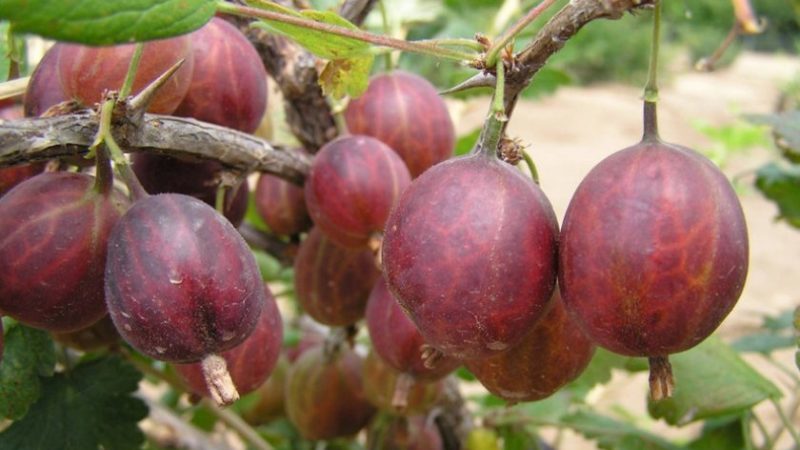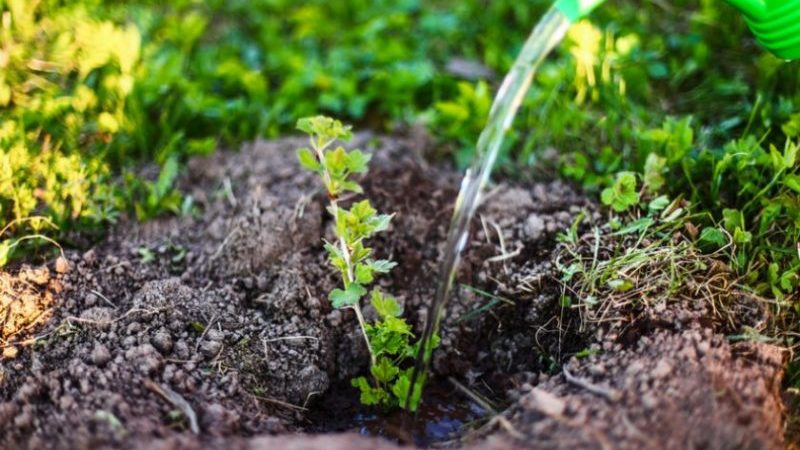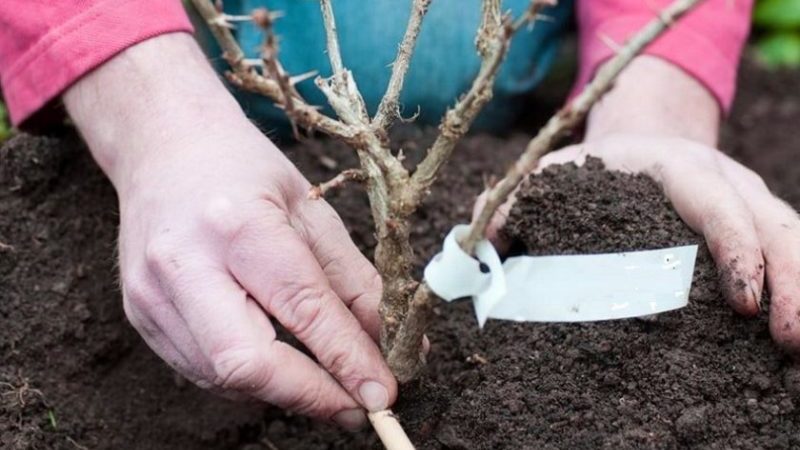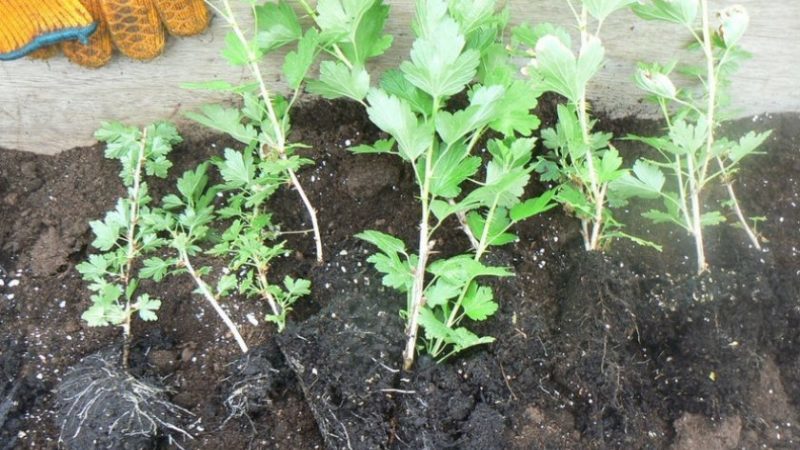Late-ripening gooseberry variety Date
The Date gooseberry variety meets the basic requirements of gardeners - it is unpretentious in care and bears fruit stably. Among the advantages are also self-fertility, resistance to drought and low temperatures, a pleasant taste of berries. Let us consider in detail the features of planting and growing this variety.
The content of the article
What is this gooseberry variety

This is a late-ripening gooseberry, the bushes of which begin to bear fruit 4 years after planting and live an average of 20-22 years.
The berries reach technical ripeness in early July and fully ripen in August. Productivity - 8-10 kg per bush.
Reference. With proper care on a fertile soil the yield reaches 25 kg per bush.
The fruits are harvested as they ripen. They are stored for 5 weeks without loss of marketability and taste.
History of origin and distribution
The date is the result of the work of Dutch breeders, although the originator of the variety is not specified. This gooseberry was patented in the XX century, in Russia it has been successfully cultivated in all regions since the times of the USSR.
Description of gooseberry variety Date
Bushes with a powerful root system extending into the ground to a depth of more than 2 m, vigorous, reaching a height of 2 m, spreading, densely leafy. Powerful straight or arched shoots are covered with medium-sized double or single sharp thorns, which are not present at the tops.
The leaf plates are small, slightly wrinkled, glossy, with large obtuse denticles along the edges, dark green colored. Floral ovaries are pale green, slightly pubescent. The flowers are collected in small white inflorescences with a slight greenish tint.
Resistant to temperatures
Date bushes tolerate air temperature drops down to -35 ° C. Cultivation in northern regions with harsher (-40 ° C and below) winters suggests additional shelter from frost.
Moisture, drought resistance and immunity
Due to the deep bedding of the root system, the bushes endure a drought lasting 2-3 weeks. Prolonged lack of moisture and its excess negatively affect the size and taste of the fruit.
The variety is prone to damage by powdery mildew, spider mites and aphids.
Characteristics and description of fruits

The berries are round or oval in shape, weighing an average of 15 g, covered with a smooth light burgundy skin with a purple blush. When growing gooseberries in a sunny area, the fruits at the stage of full ripeness become dark purple, almost black.
The pulp is green, dense, juicy and aromatic, the taste is pleasant sweet, with a slight sourness. Berries contain up to 9% sugar, but in case of a large amount of precipitation, this figure decreases.
Areas of use
The fruits of date gooseberries are consumed fresh, used to make compotes, jams, pastilles, preserves, jellies, pickles and wines. For processing and conservation, berries are used that have reached technical, and not full maturity.
Advantages and disadvantages of the variety
The main advantages of the Date:
- long fruiting period;
- stable and high yield;
- large-fruited;
- frost and drought resistance;
- good keeping quality and transportability;
- self-fertility;
- pleasant taste.
Among the disadvantages are:
- the presence of thorns on the shoots;
- a tendency to defeat powdery mildew;
- late ripening of the crop;
- the spreading of the crown, the need for space.
Growing technology
To obtain a rich harvest, it is first of all important to choose high-quality planting material and a suitable site. In the future, it will be necessary to strictly observe the agrotechnical requirements of the variety: monitor the frequency and abundance of watering, fertilization, prune bushes, and protect them from diseases and pests.
Optimal conditions

For cultivation, choose 1- or 2-year-old seedlings no more than 30 cm high, without leaves and young shoots, with a dense and flexible root system, without signs of disease and pest damage.
2 days before planting, the roots of the seedlings are placed in a solution of a growth stimulator (Kornevin, Heteroauxin) with the addition of potassium permanganate to destroy bacteria. 2 hours before planting in open ground roots process clay talker.
For planting dates, choose a well-lit place, protected from the cold wind, located on the southern side of the site, with a groundwater level of 1-2 m.
Reference. Lack of light leads to a decrease in yield and fruit quality.
The cultivar prefers a nutritious and loose soil with good moisture permeability, aeration and medium to neutral acidity (pH about 5.5). The most suitable option is loam and sandstone. The acidic soil is lime in advance or dolomite flour is added to it.
At least a month before planting, the soil is cleaned of plant residues and dug to a depth of 30 cm. 10 kg of manure or humus, 2 kg of potassium nitrate and 4 kg of superphosphate are applied to 1 m² of soil.
Terms and rules of landing
Gooseberries are planted in spring (early March) or autumn (mid September - early October), choosing a cloudy and windless day. When planting in autumn, the bushes take root better and adapt faster to new conditions.

Planting instructions:
- Every 1.5–2 m in the prepared area, dig planting holes 0.7 m deep, 0.5 m wide and 0.5 m in diameter.
- Fill them halfway with nutritious soil mixture (1/2 of the excavated soil, 10 kg of humus, 200 g of superphosphate and 2 g of potassium fertilizers).
- Cut off the shoots on the seedlings, leaving a maximum of 6 buds on them.
- Place the plants vertically in the holes, spreading the roots.
- Sprinkle them with soil so that the root collar is 8-10 cm above the soil surface.
- Compact the earth, water the plants at the rate of 10 liters of warm water for each bush.
After watering, the trunk circle is mulched with straw, humus or peat. The thickness of the mulch layer is 10 cm.
Further care
Watering is carried out every 8-10 days. Under each bush, 30 liters of water at room temperature are poured so that the earth is moistened 40 cm deep. It is especially important not to allow the soil to dry out during the formation of shoots and ovaries, during the formation and ripening of fruits.
To improve moisture and air permeability, soil is dug up annually to a depth of 15 cm in autumn and 7–10 cm in spring. To retain moisture in the ground, the trunk circle is mulched with peat or compost.
The bushes are not fed for 2 years after planting, then fertilizers are applied according to the scheme:
- during the autumn digging - 1 kg of superphosphate, 300 g of nitrate and 500 g of wood ash per 1 m²;
- in summer - 10 kg of humus or 3 kg of compost per 1 m².
Pruning is carried out twice a year: in the spring, before the beginning of the growing season, and after harvest. A year after planting, all weak shoots are removed from the bushes, leaving no more than 4 fertile buds, and the tops. From 2 years old, weak and damaged branches are cut off, last year's shoots are shortened by 1/3. In autumn, branches are removed on which ovaries and fruits no longer form.
When the bushes are 8 years old, they enter the phase of the most active fruiting. At this time, they are carefully monitored, shoots that do not yield a crop are removed along with the roots.
Formative pruning consists in removing branches growing inside the crown, overgrown shoots and shading other plants.

Possible problems, diseases, pests
Diseases and pests dangerous for Date are described in the table.
| Disease / pest | Signs | Treatment / prevention |
| Powdery mildew | A loose white bloom appears on the leaves, shoots and ovaries of the fruit, which eventually becomes dense and turns brown. The shoots are deformed and dry, the leaf plates curl, the fruits stop developing and crack. | To prevent the disease, the site is thoroughly cleaned of plant residues and weeds, twice with an interval of 5 days, treated with a solution of copper sulfate (300 g per 5 l of water) or "Fitosporin" (50 g per 6 l of water).
The disease cannot be cured, so the infected plants are dug up and burned, other bushes are treated with fungicidal preparations (Acrobat MC, Ridomil Gold MC, Oxykhom, Arcerid, Aviksil). |
| Spider mite | A thin web appears on the inside of the leaf plates, the leaves dry out and fall off. | The bushes are sprayed 2-3 times with an interval of 2 weeks with a solution of copper sulfate (20 g per 10 l of water) or the preparation "HOM" (1 ampoule per 5 l of water). |
| Aphid | Insects feed on the sap of the plant, as a result of which the internodes are deformed. |
Wintering
In October, they begin to prepare the bushes for winter. The trunk circle is cleaned of plant debris and pruning is carried out, removing all old branches. The soil in the near-trunk circle is mulched with straw and humus (layer thickness - at least 30 cm).
In the northern regions, plastic wrap or agrofibre is additionally laid on top.
Reproduction
Gooseberry bushes Dates are propagated by seeds, dividing the bush, cuttings and layering. Most often, gardeners use the latter method:
- At the end of summer, on an adult bush, choose 2-3 shoots growing below.
- Bend them to the ground, secure with special brackets and sprinkle with a layer of earth 5-10 cm thick.
- Water the cuttings regularly, the young roots on which will appear within 1-2 months.
In the spring, after wintering with the parent plant, the layers are separated and planted in a permanent place.
Features of cultivation depending on the region
Variety requirements for landing and care do not change depending on the region of cultivation.
The only thing that is important to consider is the need for additional shelter of bushes with polyethylene or agrofibre when growing dates in northern regions with harsh winters.
Pollinating varieties
The date is a self-pollinated gooseberry variety that does not need pollinating varieties for successful fruiting. At the same time, productivity indicators increase with the appearance of insects, which increase the level of pollination, and the planting of several plants in the same area.
Reviews of summer residents
Gardeners speak positively about the variety.
Victoria, Tver: “At my dacha, Phenicum has been growing for a very long time, I can't even remember exactly how many years. I like that the care of the bushes is minimal: I water it 3-4 times over the summer, feeding several times and cut. The yield is good, the berries are large and tasty. The only drawback is that the fruits do not ripen at the same time, you have to first pick them from above, and later from the lower branches. "
Vasily, Tambov: “About 10 years ago I decided to plant a gooseberry, on the advice of my neighbor I bought Dates seedlings. Now 2 bushes of this variety grow on the site, and I am more than satisfied. They bear fruit annually, the yield is excellent. We eat the berries fresh and have enough for processing: my wife cooks compotes, jam and grinds them with sugar. "
Conclusion
The date is a late-ripening self-fertile gooseberry variety that is characterized by a long fruiting period, consistently high yield, frost and drought resistance, good keeping quality, transportability and pleasant berry taste. The main disadvantages of the plant include the spikiness of the shoots and the tendency to damage by powdery mildew.